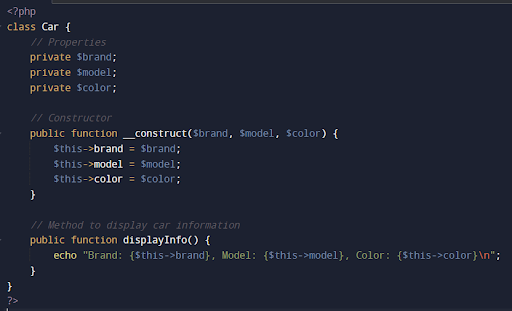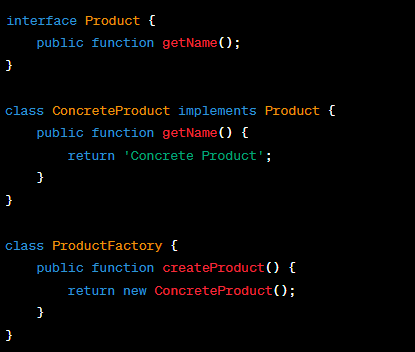Object-Oriented Programming (OOP) brings a structured approach, enhancing code organization and reusability. In this brief guide, we'll explore the core principles and syntax of Object-Oriented PHP, providing the essential knowledge to its power. Let's unravel the world of classes, objects, and inheritance to pave the way for a more efficient and sophisticated coding experience.
Introduction to Object-Oriented Programming in PHP
Object-oriented programming (OOP) in PHP enables developers to organize code into reusable classes and objects, fostering modularity, maintainability, and scalability in web application development. This approach is particularly beneficial for learners and professionals who are looking for help with PHP homework, as it lays a foundation for understanding complex programming paradigms and developing high-quality web applications.
Key Concepts of OOP in PHP: Classes, Objects, and More
The key concepts of OOP are classes and objects.
-
Classes serve as blueprints or templates that define the properties and behaviors of objects.
-
Objects, on the other hand, are instances of classes representing tangible entities in the code
Encapsulation and Data Hiding in PHP
-
Encapsulation refers to bundling data (attributes or properties) and methods (functions) within a class. This concept prevents external code from directly accessing or modifying the internal state of an object, promoting a more controlled and secure environment.
-
Data hiding is an aspect of encapsulation that involves restricting access to the internal details of a class. In PHP, visibility modifiers such as public, private, and protected are used to control the access level of properties and methods.
-
Public properties and methods can be accessed from outside the class.
-
Private properties and methods can only be accessed within the class itself. They are hidden from external code.
-
Protected properties and methods are accessible within the class and its subclasses. They provide a middle ground between public and private visibility.
Implementing OOP in PHP: Step-by-Step Guide
Implementing Object-Oriented Programming (OOP) in PHP involves several key steps. Here's a guide to start with OOP in PHP:
Define Your Classes:

Create Objects:

Access Properties and Methods:

Encapsulation and Data Hiding:

Inheritance and Polymorphism: Extending PHP Classes
Inheritance is a key OOP concept that allows a class (subclass or child class) to inherit properties and methods from another class (superclass or parent class). The child class can extend or override the functionality of the parent class, providing a way to build on existing code and create specialized classes while maintaining a common structure. Polymorphism allows objects of different classes to be treated as objects of a common base class. Polymorphism is achieved through method overriding and interfaces. Let’s continue our step-by-step guide:
Inheritance

Polymorphism

These steps provide a basic guide for implementing OOP in PHP.
Advantages of Using OOP in PHP Development
Object-Oriented Programming (OOP) offers several advantages in PHP development:
-
Code Reusability - OOP promotes the reuse of code through features like inheritance. By creating a base class with common properties and methods, you can extend it to create subclasses, inheriting and reusing the existing code.
-
Modularity - OOP enables the organization of code into modular structures, where each class represents a self-contained unit with specific functionality.
-
Flexibility and Extensibility - OOP allows for the creation of flexible and extensible code. With features like polymorphism, you can design code to be more adaptable to changes and additions.
-
Improved Testing - OOP makes it easier to write unit tests for individual classes, as each class encapsulates a specific set of functionalities.
Practical OOP Projects in PHP
Implementing practical Object-Oriented Programming (OOP) projects in PHP can be a great way to enhance your skills and build robust applications. Here are a few project ideas to consider:
-
Content Management System (CMS):
Develop a simple CMS where users can create, edit, and delete articles or blog posts. Use OOP principles to create classes for handling user authentication, managing content, and handling interactions with the database. Implement features like user roles, comments, and categories.
- Task Management System:
Create a task management system where users can create, update, and delete tasks. Use OOP to design classes for tasks, users, and task categories. Implement features like task deadlines, priority levels, and user authentication.
-
Online Quiz System:
Build an online quiz platform with the ability to create quizzes, take quizzes, and view results. Use OOP to design classes for quizzes, questions, and users. Implement features like multiple-choice questions, scoring, and user profiles.
Common OOP Design Patterns in PHP
Object-Oriented Programming (OOP) design patterns are reusable solutions to common problems encountered in software design. They provide guidelines and best practices for structuring code, enhancing flexibility, and promoting maintainability. In PHP, several design patterns are commonly employed. Some of these include:
-
Observer Pattern: is a behavioral design pattern where an object, known as the subject, maintains a list of its dependents, called observers, which are notified and updated automatically when the subject changes its state.
-
Strategy Pattern: is a behavioral design pattern that defines a family of algorithms, encapsulates each algorithm, and makes them interchangeable. It allows the client to choose and switch between algorithms at runtime without altering the client's code, promoting flexibility and ease of maintenance in software design.
-
Decorator Pattern: is a structural design pattern that enables behavior to be added to an individual object, either statically or dynamically, without affecting the behavior of other objects from the same class. It involves attaching new responsibilities to objects by placing them inside wrapper classes that contain the additional behavior.
-
Facade Pattern: Provides a unified interface to a set of interfaces in a subsystem, making it easier to use and reducing dependencies.
-
Iterator Pattern: is a behavioral design pattern that provides a systematic way to access elements of a collection without exposing the underlying details of its representation.
The Singleton and Factory Patterns in PHP
Singleton Pattern
Definition: The Singleton pattern ensures that a class has only one instance and provides a global point of access to that instance.
Implementation in PHP:

Usage:

Explanation:
In this example, the Singleton class has a private static property $instance to store the single instance of the class. The constructor is private to prevent external instantiation. The getInstance method ensures that there is only one instance of the class and provides global access to it. If an instance does not exist, it creates one; otherwise, it returns the existing instance.
Factory Pattern:
Definition: The Factory pattern provides an interface for creating objects in a superclass but allows subclasses to alter the type of objects that will be created.
Implementation in PHP:

Usage:

Explanation:
In this example, the Product interface declares the method getName(). The ConcreteProduct class implements this interface. The ProductFactory class has a method createProduct() that creates and returns an instance of the ConcreteProduct class. This way, the client code using the factory is abstracted from the specific class instantiation, allowing flexibility in changing or extending product types.
FAQ:
What is Object-Oriented Programming in PHP?
OOP in PHP is a paradigm that revolves around the concept of objects, which are instances of classes. In OOP, code is organized into classes, representing abstract data types and objects, instances of these classes that encapsulate data and behavior. PHP, a server-side scripting language, supports OOP features that facilitate the development of scalable, modular, and maintainable applications.
How do I implement OOP concepts in PHP?
To implement Object-Oriented Programming (OOP) concepts in PHP, follow these key principles:
-
Classes and Objects: Define classes to represent abstract data types, encapsulating properties (attributes) and methods (functions).
-
Encapsulation: Encapsulate the internal details of a class by bundling properties and methods within it. Control access to these properties and methods (public, private, protected).
-
Inheritance: Utilize inheritance to create a hierarchy of classes. A subclass can inherit properties and methods from a parent class.
-
Polymorphism: Implement polymorphism, allowing objects to be treated as instances of their parent class. Polymorphism is often achieved through method overriding.
What are the benefits of using OOP in PHP?
The benefits of using OOP in PHP include:
-
Code Reusability: OOP promotes the reuse of code through inheritance and encapsulation, reducing redundancy and making the codebase more efficient.
-
Modularity: Classes and objects contribute to a modular code structure, making it easier to understand, maintain, and update the code.
-
Encapsulation and Data Hiding: Encapsulation enhances security and data integrity by controlling access to the internal state of objects.
-
Flexibility and Extensibility: OOP allows for flexible and extensible code, supporting the addition of new features without modifying existing code.
-
Readability and Maintainability: OOP enhances code readability, facilitating easier maintenance and updates. It provides a clear structure for organizing and managing code.
By leveraging OOP in PHP, developers can build scalable and well-organized applications.

